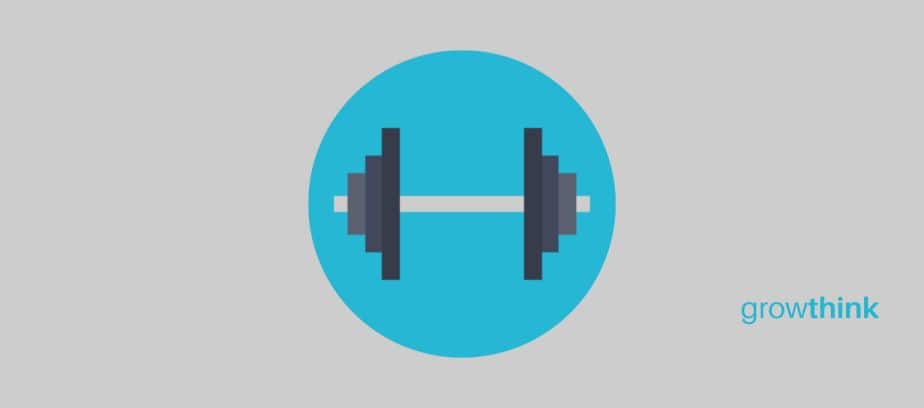
ON THIS PAGE
- How to Start a Gym
- 15 Steps To Start a Gym Business
- How Big is the Gym Industry?
- What are the Key Segments of the Gym Industry?
- What External Factors affect the Gym Industry?
- What are the Key Customer Segments in the Gym Industry?
- What are the Typical Startup Costs for a New Gym?
- Helpful Videos
- Additional resources in the Gym Industry
How to Start a Gym
If you’re looking to start a gym, you’ve come to the right place since we’re going to show you exactly how to do it.
We’ll start with key gym industry fundamentals like how big the market is, what the key segments are, and how revenues and profits are generated.
Then we’ll discuss keys to not only starting a gym, but succeeding in it!
And don’t forget to look at our gym business plan template if you need a plan to start or grow your gym.
15 Steps To Starting a Gym Business:
Starting a gym can be very profitable. With proper planning, execution and hard work, you can enjoy great success. Below you will learn the keys to launching a successful gym business.
1. Choose the Name for Your Gym Business
The first step to starting a gym business is to choose your business’ name.
This is a very important choice since your company name is your brand and will last for the lifetime of your business. Ideally you choose a name that is meaningful and memorable. Here are some tips for choosing a name for your gym:
- Make sure the name is available. Check your desired name against trademark databases and your state’s list of registered business names to see if it’s available. Also check to see if a suitable domain name is available.
- Keep it simple. The best names are usually ones that are easy to remember, pronounce and spell.
- Think about marketing. Come up with a name that reflects the desired brand and/or focus of your gym.
2. Determine the Type of Gym Business You Will Launch
When determining the type of gym business you will launch, it’s essential to consider various factors to align your business with your goals, target market, and available resources. Here are some popular types of gyms to consider:
- Traditional Gym: This type of gym offers a wide range of fitness equipment, including cardio machines, weightlifting equipment, and group exercise classes. It caters to a broad audience and is suitable for those looking for a well-rounded fitness experience.
- CrossFit Gym: CrossFit gyms focus on high-intensity functional fitness training. They often have a strong community aspect and offer group workouts that emphasize strength and conditioning.
- Yoga Studio: Yoga studios specialize in yoga and meditation classes. They are popular among individuals seeking flexibility, stress relief, and mindfulness.
- Spin or Cycling Studio: These gyms offer indoor cycling classes with specialized equipment. They are popular for intense cardio workouts and often have a dedicated following.
-
Boxing or MMA Gym: Catering to those interested in combat sports, these gyms offer boxing, kickboxing, or mixed martial
arts classes. They can attract a dedicated niche clientele.
3. Develop Your Gym Business Plan
One of the most important steps in starting a gym is to develop your business plan. The process of creating your plan ensures that you fully understand your market and your business strategy. The plan also provides you with a roadmap to follow and if needed, to present to funding sources to raise capital for your business.
To enhance your planning process, incorporating insights from a sample gym business plan can be beneficial. This can provide you with a clearer perspective on industry standards and effective strategies, helping to solidify your own business approach.
Your business plan should include the following sections:
- Executive Summary – this section should summarize your entire business plan so readers can quickly understand the key details of your gym.
- Company Overview – this section tells the reader about the history of your gym and what type of gym business you operate. For example, are you a traditional gym, crossfit gym or boxing gym.
- Industry Analysis – here you will document key information about the gym industry. Conduct market research and document how big the industry is and what trends are affecting it.
- Customer Analysis – in this section, you will document who your ideal or target customers are and their demographics. For example, how old are they? Where do they live? What do they find important when purchasing services like the ones you will offer?
- Competitive Analysis – here you will document the key direct and indirect competitors you will face and how you will build competitive advantage.
- Marketing Plan – your marketing plan should address the 4Ps: Product, Price, Promotions and Place.
- Product: Determine and document what products/services you will offer
- Prices: Document the prices of your products/services
- Place: Where will your business be located and how will that location help you increase sales?
- Promotions: What promotional methods will you use to attract customers to your gym? For example, you might decide to use pay-per-click advertising, public relations, search engine optimization and/or social media marketing.
- Operations Plan – here you will determine the key processes you will need to run your day-to-day operations. You will also determine your staffing needs. Finally, in this section of your plan, you will create a projected growth timeline showing the milestones you hope to achieve in the coming years.
- Management Team – this section details the background of your company’s management team.
- Financial Plan – In this section, you will document the financial projections for your gym. This should include your sales and revenue projections, cash flow statement, and your expense budget, detailing the gym startup costs.
- What startup costs will you incur?
- How will your gym make money?
- What are your projected sales and expenses for the next five years?
- Do you need to raise funding to launch your business?
Finish Your Business Plan Today!
If you’d like to quickly and easily complete your business plan, download Growthink’s Ultimate Business Plan Template and complete your plan and financial model in hours.
4. Choose the Legal Structure for Your Gym Business
Next you need to choose a legal structure for your gym and register it and your business name with the Secretary of State in each state where you operate your business.
Below are the five most common legal structures:
1) Sole proprietorship
A sole proprietorship is a business entity in which the owner of the gym and the business are the same legal person. The owner of a sole proprietorship is responsible for all debts and obligations of the business. There are no formalities required to establish a sole proprietorship, and it is easy to set up and operate. The main advantage of a sole proprietorship is that it is simple and inexpensive to establish. The main disadvantage is that the owner is liable for all debts and obligations of the business.
2) Partnerships
A partnership is a legal structure that is popular among small businesses. It is an agreement between two or more people who want to start a gym business together. The partners share in the profits and losses of the business.
The advantages of a partnership are that it is easy to set up, and the partners share in the profits and losses of the business. The disadvantages of a partnership are that the partners are jointly liable for the debts of the business, and disagreements between partners can be difficult to resolve.
3) Limited Liability Company (LLC)
A limited liability company, or LLC, is a type of business entity that provides limited liability to its owners. This means that the owners of an LLC are not personally responsible for the debts and liabilities of the business. The advantages of an LLC for a gym include flexibility in management, pass-through taxation (avoids double taxation as explained below), and limited personal liability. The disadvantages of an LLC include lack of availability in some states and self-employment taxes.
4) C Corporation
A C Corporation is a business entity that is separate from its owners. It has its own tax ID and can have shareholders. The main advantage of a C Corporation for a gym is that it offers limited liability to its owners. This means that the owners are not personally responsible for the debts and liabilities of the business. The disadvantage is that C Corporations are subject to double taxation. This means that the corporation pays taxes on its profits, and the shareholders also pay taxes on their dividends.
5) S Corporation
An S Corporation is a type of corporation that provides its owners with limited liability protection and allows them to pass their business income through to their personal income tax returns, thus avoiding double taxation. There are several limitations on S Corporations including the number of shareholders they can have among others.
Once you register your gym, your state will send you your official “Articles of Incorporation.” You will need this among other documentation when establishing your banking account (see below). We recommend that you consult an attorney in determining which legal structure is best suited for your company.
5. Secure Startup Funding for Your Gym Business (If Needed)
In developing your gym business plan, you might have determined that you need to raise funding to launch your business.
If so, the main sources of funding for a gym to consider are personal savings, family and friends, credit card financing, bank loans, crowdfunding and angel investors. Angel investors are individuals who provide capital to early-stage businesses. Angel investors typically will invest in a gym that they believe has high potential for growth.
6. Secure a Location for Your Business
Securing a suitable location for your gym is a crucial step in its success. Here are the key steps to secure a location:
- Define Your Target Market: Before choosing a location, understand your target market. Consider demographics, income levels, and fitness preferences of potential members. This information will help you identify areas where your gym is likely to thrive.
- Market Research: Conduct thorough market research to assess the competition and demand in various areas. Look for gaps in the market that your gym could fill. Evaluate factors such as population density, proximity to residential areas, and accessibility.
- Budget Assessment: Determine your budget for leasing or purchasing a location. Consider not only the initial costs but also ongoing expenses like rent, utilities, maintenance, and taxes.
- Real Estate Agent: Hire a real estate agent who specializes in commercial properties. They can help you find available spaces that fit your criteria, negotiate lease terms, and guide you through the process.
- Location Criteria: Choose a visible, accessible, and safe location.
7. Register Your Gym Business with the IRS
Next, you need to register your business with the Internal Revenue Service (IRS) which will result in the IRS issuing you an Employer Identification Number (EIN).
Most banks will require you to have an EIN in order to open up an account. In addition, in order to hire employees, you will need an EIN since that is how the IRS tracks your payroll tax payments.
Note that if you are a sole proprietor without employees, you generally do not need to get an EIN. Rather, you would use your social security number (instead of your EIN) as your taxpayer identification number.
8. Open a Business Bank Account
It is important to establish a bank account in your gym’s name. This process is fairly simple and involves the following steps:
- Identify and contact the bank you want to use
- Gather and present the required documents (generally include your company’s Articles of Incorporation, driver’s license or passport, and proof of address)
- Complete the bank’s application form and provide all relevant information
- Meet with a banker to discuss your business needs and establish a relationship with them
9. Get a Business Credit Card
You should get a business credit card for your gym to help you separate personal and business expenses.
You can either apply for a business credit card through your bank or apply for one through a credit card company.
When you’re applying for a business credit card, you’ll need to provide some information about your business. This includes the name of your business, the address of your business, and the type of business you’re running. You’ll also need to provide some information about yourself, including your name, Social Security number, and date of birth.
Once you’ve been approved for a business credit card, you’ll be able to use it to make purchases for your business. You can also use it to build your credit history which could be very important in securing loans and getting credit lines for your business in the future.
10. Get the Required Business Licenses and Permits
Every state, county and city has different business license and permit requirements.
Nearly all states, counties and/or cities have license requirements including. However, here are common licenses and permits you may need:
- Business License: A general business license is typically required to operate any business legally. You can obtain this from your city or county government.
- Zoning Permit: Verify that your chosen location is zoned for fitness facilities or gyms. You may need a zoning permit if the zoning isn’t already in place.
- Health Department Permit: Gyms often need approval from the local health department to ensure cleanliness and safety standards. This may include inspections of facilities and equipment.
- Building and Sign Permits: If you’re making renovations to the space or installing signage, you may need permits from the local building department.
- Occupancy Permit: Some areas require an occupancy permit to ensure your gym complies with safety and capacity regulations.
- Fire Department Permit: Depending on your location and the size of your gym, you may need a fire department permit to assess fire safety measures.
-
Music License: If you play music in your gym, you might need a license to ensure compliance with copyright laws.
Depending on the type of gym you launch, you will have to obtain the necessary state, county and/or city licenses.
11. Get Business Insurance for Your Gym Business
Here are the key types of insurance you’ll likely need for your gym:
- General Liability Insurance: This insurance provides coverage for bodily injury, property damage, or personal injury claims that may arise from accidents or incidents on your gym premises. It’s a fundamental insurance policy for any business and is essential for gyms.
- Professional Liability Insurance (Errors and Omissions): If you offer personal training services or fitness instruction, professional liability insurance can protect you from claims related to injuries or dissatisfaction with your services.
- Property Insurance: Property insurance covers damage or loss of your gym’s physical assets, including equipment, fixtures, and the building itself (if you own the property). It protects against events like fire, theft, vandalism, or natural disasters.
- Workers’ Compensation Insurance: If you have employees, workers’ compensation insurance is typically required by law. It covers medical expenses and lost wages for employees who are injured or become ill while on the job.
- Business Interruption Insurance:This insurance helps cover financial losses if your gym has to temporarily close due to a covered event, such as a fire or natural disaster. It can compensate for lost income and ongoing expenses during the closure.
- Product Liability Insurance: If you sell fitness equipment or supplements at your gym, this insurance can protect you from liability claims related to injuries or damages caused by those products.
Find an insurance agent, tell them about your business and its needs, and they will recommend policies that fit those needs.
12. Buy or Lease the Right Gym Equipment
The equipment you’ll need to run your gym depends on the type of gym you plan to operate and the services you intend to offer.
Here’s a general list of essential equipment that you may need for a well-rounded gym:
- Strength Training Equipment:
- Dumbbells
- Barbells and weight plates
- Benches (flat, incline, decline)
- Power racks or squat racks
- Smith machines
- Leg press machines
- Cable machines
- Resistance bands and tubing
- Cardiovascular Equipment:
- Treadmills
- Elliptical machines
- Stationary bikes (upright and recumbent)
- Rowing machines
- Stair climbers or step machines
- Cross trainers
- Functional Fitness Equipment:
- Kettlebells
- Medicine balls
- Battle ropes
- Suspension trainers (e.g., TRX)
- Plyometric boxes
- Agility ladders
- Sleds and prowlers
- Machines and Accessories:
- Lat pulldown machines
- Leg curl and extension machines
- Chest press machines
- Shoulder press machines
- Cable attachments (handles, bars)
- Weight lifting belts and gloves
- Cardio Theater Equipment:
- Flat-screen TVs
- Audio systems or speakers
- Entertainment options for members
- Stretching and Recovery Equipment:
- Foam rollers
- Yoga mats and blocks
- Stretching machines
- Massage tables or chairs
- Hot tub or sauna (optional)
- Hygiene and Sanitary Equipment:
- Hand sanitizers and dispensers
- Cleaning supplies (disinfectant sprays, wipes)
- Towel racks and bins
- Locker Room Facilities:
- Lockers
- Benches or seating
- Showers and restroom facilities
- Vanity areas with mirrors
- Fitness Accessories:
- Resistance bands
- Stability balls
- Jump ropes
- Ankle weights
- Yoga and Pilates props
- Safety Equipment:
- First aid kits
- AED (automated external defibrillator)
- Fire extinguishers
- Security cameras (for security and member safety)
13. Develop Your Gym Business Marketing Materials
As part of your gym marketing plan, marketing materials will be required to attract and retain customers to your gym.
The key marketing materials you will need are as follows:
- Logo: Spend some time developing a good logo for your gym. Your logo will be printed on company stationery, business cards, marketing materials and so forth. The right logo can increase customer trust and awareness of your brand.
- Website: Likewise, a professional gym website provides potential customers with information about the services you offer, your company’s history, and contact information. Importantly, remember that the look and feel of your website will affect how customers perceive you.
- Social Media Accounts: Establish social media accounts in your company’s name. Accounts on Facebook, Twitter, LinkedIn and/or other social media networks will help customers and others find and interact with your gym.
14. Purchase and Setup the Software Needed to Run Your Gym Business
Running a gym efficiently often requires a combination of software solutions to manage various aspects of the business.
Here’s a list of essential software for a gym business:
- Gym Management Software: Comprehensive gym management software helps you manage various aspects of your business, including member management, billing, scheduling, and reporting. Some popular gym management software options include Mindbody, GymMaster, and Zen Planner.
- Member Management Software: This software allows you to keep track of member profiles, including contact information, membership status, and attendance history. It can help with member engagement and retention.
- Billing and Payment Processing: Software for billing and payment processing streamlines membership billing, recurring payments, and point-of-sale transactions. Popular options include Stripe, Square, and specialized gym billing solutions.
- Scheduling and Class Management: Software for scheduling classes, personal training sessions, and appointments is essential for organizing your gym’s activities. Mindbody and BookSteam are examples of software that offer scheduling features.
- Booking and Reservation Systems: If you offer services like personal training or massage therapy, booking and reservation software can help manage appointments and availability.
15. Open for Business
You are now ready to open your gym. If you followed the steps above, you should be in a great position to build a successful business. Below are answers to frequently asked questions that might further help you.
Finish Your Business Plan Today!
If you’d like to quickly and easily complete your business plan, download Growthink’s Ultimate Business Plan Template and complete your plan and financial model in hours.
How Big is the Gym Industry?
The Gym industry is made up of nearly 95,000 businesses. Industry revenue has grown at an average annual rate of 2.5%, hitting $30.3 billion last year.
What are the Key Segments of the Gym Industry?
The main revenue source for the industry is membership fees. The other sources of revenue include:
- Personal training services
- Guest admission sales
- Athletic instruction – excluding personal training services
- Meals and beverages, merchandise, and spa services
What External Factors Affect the Gym Industry?
A number of factors affect the performance of the Gym Industry. These drivers include:
- Participation in sports: The rise in health-consciousness across the US has spurred increased participation in all kinds of sports. When sports participation increases, the demand for gym membership also increases.
- Time spent on leisure and sports: As unemployment levels continue to decline, Americans have less time to spend on leisure activities, including sports.
- Per capita disposable income: On the other hand, declining unemployment means that Americans are better able to afford gym memberships.
- Number of adults aged 20 to 64: Most gym-goers are between the ages of 20 and 64, and when this demographic grows, the pool of prospective clients gets deeper.
What are the Key Customer Segments in the Gym Industry?
The key customer segments in the Gym Industry those aged 34 and younger. Consumers aged 35 to 54 are the second largest segment, followed by those aged 55 and older.
Finish Your Business Plan Today!
If you’d like to quickly and easily complete your business plan, download Growthink’s Ultimate Gym Business Plan Template and complete your plan and financial model in hours.
What are the Typical Startup Costs for a New Gym?
Starting a new gym costs around $150,000 to $200,000.
Startup costs will include:
- Rent and rental deposit
- Gym equipment
- Office equipment
- Legal and professional fees
- Marketing
Ongoing costs will include:
- Rent/mortgage
- Gym equipment – repairs and replacement
- Marketing
- Wages/commissions
- Laundry service
- Cleaning supplies
Helpful Videos
Marketing Strategies – How do I promote my gym?
5 Keys to Fitness Center Marketing
17 Habits Of Successful Fitness Entrepreneurs
Additional resources for How to Start a Gym Business
For additional information on the gym market, consider these industry resources:
- International Health, Racquet and Sportsclub Association: www.ihrsa.org
- Sports and Fitness Industry Association: www.sfia.org
- National Association for Health and Fitness: www.physicalfitness.org
Gym Business Plan Example PDF
Download our gym business plan pdf here. This is a free gym business plan example to help you get started on your own gym plan.
How to Finish Your Gym Business Plan in 1 Day!
Don’t you wish there was a faster, easier way to finish your business plan?
With Growthink’s Ultimate Gym Business Plan Template you can finish your plan in just 8 hours or less!
Click here to finish your gym business plan today.
OR, Let Us Develop Your Plan For You
Since 1999, Growthink has developed business plans for thousands of companies who have gone on to achieve tremendous success.
Click here to see how Growthink’s business plan consulting services can create your business plan for you.

 Business Plan Template & Guide For Small Businesses
Business Plan Template & Guide For Small Businesses How To Write A Great Business Plan
How To Write A Great Business Plan Gym Business Plan Template
Gym Business Plan Template